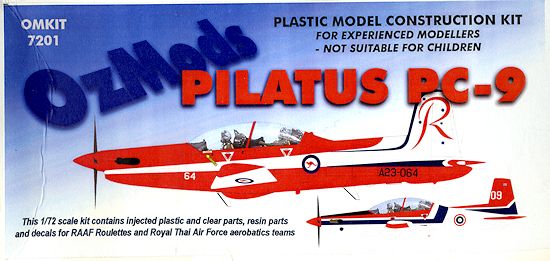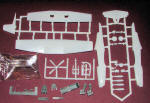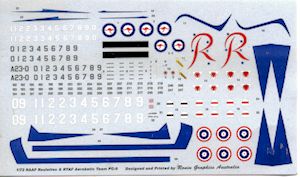
OZ Mods 1/72 Pilatus PC-9
| KIT #: | OMKIT 7201 |
| PRICE: | AUD$39.60 direct from www.ozmods-kits.com |
| DECALS: | Two options |
| REVIEWER: | Scott Van Aken |
| NOTES: | Short run with resin parts |

| HISTORY |
The PC-9 is a more powerful evolution of the PC-7. It retains the overall layout of its predecessor, but it has very little structural commonality with it. Amongst other improvements, the PC-9 features a larger cockpit with stepped ejection seats and also has a ventral airbrake.
The PC-9 program officially started in 1982. Although some aerodynamic elements were tested on a PC-7 during 1982 and 1983, the first flight of the first PC-9 prototype took place on 7 May 1984. A second prototype flew on 20 July of the same year; this prototype had all the standard electronic flight instrumentation and environmental control systems installed and was thus almost fully representative of the production version.
Certification was achieved in September 1985. By this time, the PC-9 had lost the RAF trainer competition to the Short Tucano. However, the marketing links that Pilatus built up with British Aerospace during the competition stood them in good stead, as it soon led to their first order from Saudi Arabia.
The aircraft has had success in military sales including a large order from the United States for 700 of a modified version to be built by Beechcraft with royalties going to Pilatus. The Royal Australian Air Force operates 67 aircraft – two were supplied directly by Pilatus, 17 were assembled from Pilatus-supplied kits and 48 were built in Australia by Hawker de Havilland. The type is also used by the Roulettes aerobatic display team of the RAAF. These replaced the jet powered Macchi 326.
| THE KIT |
 This is OZ Mods first venture into 1/72 injected plastic kits as far as I can tell. The kit is a low pressure short run kit as is evident from the fairly substantial sprues. All of the parts show some small amount of flash on them, but this is not an issue as one would be cleaning the mold seam lines anyway. I did notice some stress cracks on the surface of the large parts. These are quite shallow and may well disappear once one primes the white plastic parts.
This is OZ Mods first venture into 1/72 injected plastic kits as far as I can tell. The kit is a low pressure short run kit as is evident from the fairly substantial sprues. All of the parts show some small amount of flash on them, but this is not an issue as one would be cleaning the mold seam lines anyway. I did notice some stress cracks on the surface of the large parts. These are quite shallow and may well disappear once one primes the white plastic parts.
The kit has a one piece upper wing that includes the wing tips of the lower section (which is also a single casting. The tailplane and fin section are also a single piece. Other parts in plastic are the landing gear, wheels, gear door, prop, and spinner. The kit provided an 'engine running' prop or gives you the option of installing separate blades so the prop can be displayed as feathered, a standard feature of turboprops when the engines shut down. My full prop was missing a blade and it was not to be found anywhere so it must have broken off prior to packaging or at least before the unsealed zip bag was put into the box. This will not be an issue for me as I build my planes on the ground with the engine off.
Resin is used for the cockpit bits and the nose gear door (for the gear up option) as well as for the engine exhaust. The resin is well done and as often happens, one of the control sticks in my sample had broken free. I fully blame the poor handling by the postal system for this as the box for my sample was badly crushed when it arrived and I'm surprised more was not broken. The kit includes both an injected as well as two vacuformed canopy for those who would prefer the thinner option.
Instructions are well done and show photos of all the parts as well as exploded views for construction. The only color info during building is to paint the cockpit FS 34227 green and google for more details. The instructions also suggest 7-8 grams of nose weight and a 'how to' when it comes to coating a canopy with Future to improve its clarity. I saw no information on inner gear wells/doors so will assume these are the now-standard white. Gear legs and wheels are aluminum according to photos on the net. The instructions also recommend cleaning all the parts and test fitting prior to cementing, always good advice for short run kits.
 Markings are provided for two very colorful planes. One is the box art plane for the RAAF display team, the Roulettes. You are provided the dark blue areas as decals and a variety of serial numbers so you can model any plane for which you have a photo. Masking will be needed for the rest of the red/white scheme. It would have been nice to have a pair of 2 FTS tail markings to do a standard trainer, but perhaps that will be in a future boxing. The other option is for a plane of the Thai Air Force display team. Again, the dark blue bits are given as decals and a full round of serial numbers for the nose gear doors are provided to do any plane in the team. The decals themselves are superbly printed by Ronin Graphics and include the full array of data markings as well.
Markings are provided for two very colorful planes. One is the box art plane for the RAAF display team, the Roulettes. You are provided the dark blue areas as decals and a variety of serial numbers so you can model any plane for which you have a photo. Masking will be needed for the rest of the red/white scheme. It would have been nice to have a pair of 2 FTS tail markings to do a standard trainer, but perhaps that will be in a future boxing. The other option is for a plane of the Thai Air Force display team. Again, the dark blue bits are given as decals and a full round of serial numbers for the nose gear doors are provided to do any plane in the team. The decals themselves are superbly printed by Ronin Graphics and include the full array of data markings as well.
| CONCLUSIONS |
Prior to this kit, the only other 1/72 injected PC-9 was done by Aeroclub and with the demise of that company is no longer available. This one is an excellent replacement for that kit as it is not only more accurate, but offers much better cockpit detail. The PC-9 is and was operated by a number of foreign air arms so one can hope that there will be future boxings for some of these other aircraft. Recommended for those who have short run kit experience.
| REFERENCES |
http://en.wikipedia.org/wiki/Pilatus_PC-9
July 2014 Thanks to OZ Mods for the preview kit. Get yours today at this link. If you would like your product reviewed fairly and fairly quickly, please contact the editor or see other details in the